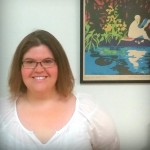Novak – Question 2
By
Joy R. Novak
November 2015
2In what ways is your organization, or your role, radical? In what ways is it not?
Joy R. Novak
Collections Manager – Center for the Study of Political Graphics
¶ 1 Leave a comment on paragraph 1 0 CSPG is radical primarily because of the grassroots history and development of the organization, as well as its current programming. With its focus on social-justice posters and ephemera, the collection contains records that reference largely under-documented topics, issues, and communities. CSPG has two collecting criteria: 1) Works must be produced in multiples (such as offsets, silkscreens, stencils, woodcuts, etc.). 2) Works must be overtly political. CSPG accepts and welcomes posters representing any political ideology, although the vast majority of the works in the collection are from the Left. It documents diverse human-rights issues and social-justice movements. Approximately 40 percent of the collection is either produced internationally or about international solidarity.
¶ 2 Leave a comment on paragraph 2 0 CSPG developed from the personal collection of the founder, Carol Wells, who began actively collecting posters in 1981 with the specific intention of creating exhibitions to bring attention to US interventions in Central America. As the exhibitions traveled, she continued to collect more posters and develop more exhibitions around other issues, including women’s rights, apartheid, and labor solidarity. The collection grew out of these initial grassroots efforts and activities, and was then turned into a non-profit organization in 1989. The collection continues to grow almost exclusively by donations from poster collectors, artists, and organizers, on an average of 3,000 to 5,000 posters annually.
¶ 3 Leave a comment on paragraph 3 0 CSPG’s programming, which includes educational panels and poster-making workshops, often deliberately engages communities that are traditionally underserved by the arts, both in terms of socio-economic region and demographics—for example, LGBTQ youth and families impacted by the prison industrial complex. We have maintained a close relationship with our local community in Los Angeles and try to encourage community engagement and grassroots programming whenever possible. One of CSPG’s new programs that has allowed greater opportunities for community engagement is called “Exhibitions-to-Go,” a flexible new exhibition format consisting of high-quality, laminated, digitally reproduced versions of our original posters. This exhibition is easy to install and does not require the same security or environmental conditions as an exhibition of original posters, allowing for display outside of a formal gallery setting in alternative spaces such as community centers, libraries, and even outdoor festivals, thus broadening CSPG’s outreach to underserved audiences.
¶ 4 Leave a comment on paragraph 4 0 In addition to this grassroots programming, which may be considered “radical,” CSPG is also a research center that hosts diverse scholars. CSPG has been making efforts to process and catalog the collection to make it accessible to researchers since its incorporation in 1989. Such access and preservation activities include arrangement, description, and digitization. In 2012, CSPG was awarded its first federal grant from the National Historical Publications and Records Commission (NHPRC) for a large-scale processing and description project to bring more comprehensive access to the collection. Prior to this grant, cataloging was performed only on the item level, providing significant detail on individual items but leaving the bulk of the collection with little intellectual access. For the NHPRC project, CSPG performed folder-level cataloging on the collection, incorporating Describing Archives: A Content Standard (DACS) to generate EAD1 finding aids for the collection now published on the Online Archive of California. Incorporating professional standards to create a searchable collection finding aid has broadened our research base, exposing us to a wider research audience and encouraging further use, specifically from the academic community. In such ways, we are balancing more standard practices with our grassroots or “radical” programming or collecting focus.
- ¶ 5 Leave a comment on paragraph 5 0
- EAD, or Encoded Archival Description, is a standard for encoding archival finding aids in XML maintained by the Society of American Archivists and the Library of Congress. [↩]


0 Comments on the whole post
Leave a comment on the whole post
0 Comments on paragraph 1
Leave a comment on paragraph 1
0 Comments on paragraph 2
Leave a comment on paragraph 2
0 Comments on paragraph 3
Leave a comment on paragraph 3
0 Comments on paragraph 4
Leave a comment on paragraph 4
0 Comments on paragraph 5
Leave a comment on paragraph 5